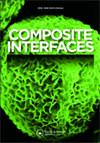纤维不规则表面和脱粘对黄麻/环氧复合材料弹性性能影响的细观力学和有限元方法
IF 2.4
4区 材料科学
Q3 MATERIALS SCIENCE, COMPOSITES
引用次数: 0
摘要
本研究考察了不规则表面和脱粘对黄麻/环氧复合材料的影响。该研究采用微观力学和有限元(FE)分析研究了材料在纵向(E1)和横向(E2)方向上的弹性模量、主泊松比(ν12)和次泊松比(ν21)以及界面应力(σ1, σ2, τ12, τ23, τ13)等特性。通过实验和分析结果对有限元模型进行了验证,结果吻合较好。然后,扩展有限元模型,分析不同纤维体积分数(Vf)对不同不规则表面(IRS%)和脱粘(DBS%)的黄麻/环氧复合材料的影响。通过这些变量比较了界面应力。DBS%导致E2和σ2的显著变化,而IRS%导致出剪应力超过阈值。在一定纤维体积分数下,增加IRS%和DBS%对E1无显著影响。然而,将Vf从10-70%增加,E1增加168%。E2则随Vf降低63-68%。IRS%和DBS%对界面应力均有显著影响。本文章由计算机程序翻译,如有差异,请以英文原文为准。
Micromechanics and finite element approaches on the influence of fibre irregular surface and debonding on the elastic properties of jute/epoxy composites
This study examines how irregular surfaces and debonding affect jute/epoxy composites. The study used micromechanics and finite element (FE) analysis to investigate properties such as elastic modulus in the longitudinal (E1) and transverse (E2) directions, major (ν12) and minor (ν21) Poisson’s ratios, and interfacial stresses (σ1, σ2, and τ12, τ23, τ13). The FE models were validated using experimental and analytical results, which showed good agreement. Then, the FE model was extended to analyse the influence of different fibre volume fractions (Vf) on jute/epoxy composites with varied irregular surfaces (IRS%) and debonding (DBS%). The interfacial stress was compared across these variables. DBS% caused significant variation in E2 and σ2, while IRS% led to out-of-shear stresses that crossed the threshold. An increase in IRS% and DBS% at a constant fibre volume fraction did not significantly affect E1. However, increasing Vf from 10–70% increased E1 by 168%. E2, on the other hand, decreased with Vf by 63–68%. Both IRS% and DBS% had a significant influence on interfacial stresses.
求助全文
通过发布文献求助,成功后即可免费获取论文全文。
去求助
来源期刊

Composite Interfaces
工程技术-材料科学:复合
CiteScore
5.00
自引率
3.80%
发文量
58
审稿时长
3 months
期刊介绍:
Composite Interfaces publishes interdisciplinary scientific and engineering research articles on composite interfaces/interphases and their related phenomena. Presenting new concepts for the fundamental understanding of composite interface study, the journal balances interest in chemistry, physical properties, mechanical properties, molecular structures, characterization techniques and theories.
Composite Interfaces covers a wide range of topics including - but not restricted to:
-surface treatment of reinforcing fibers and fillers-
effect of interface structure on mechanical properties, physical properties, curing and rheology-
coupling agents-
synthesis of matrices designed to promote adhesion-
molecular and atomic characterization of interfaces-
interfacial morphology-
dynamic mechanical study of interphases-
interfacial compatibilization-
adsorption-
tribology-
composites with organic, inorganic and metallic materials-
composites applied to aerospace, automotive, appliances, electronics, construction, marine, optical and biomedical fields
 求助内容:
求助内容: 应助结果提醒方式:
应助结果提醒方式:


